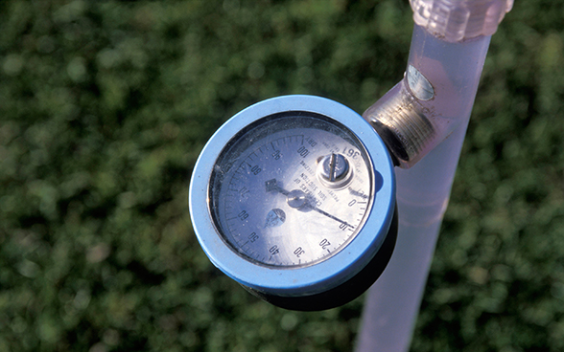Together with the Federal Office for Agriculture (FOAG), the FOEN operates the Swiss soil monitoring network (NABO). NABO is not only a reference network, but also an instrument for detecting problems early on and evaluating the effectiveness of soil protection efforts.

NABO has been operated jointly since 1984 by the FOEN and the FOAG. It provides the cantons with the necessary data for monitoring soil pollution. Agroscope is responsible for its implementation.
Physical pressures: soil compaction and erosion
Up to 40% of arable land is affected by water erosion. The main cause of erosion in Switzerland are farming methods that are unsuited to the location. Agricultural soil on slopes with little vegetation cover is particularly at risk. Due to climate change, some areas can expect an increase in erosion.
The scale of soil compaction is not yet quantifiable as measurement and evaluation methods are still being tested.
Chemical pressures: pollution levels
Significant changes in cadmium, nickel, chrome and cobalt levels have not been observed in the last 20 years. Lead and mercury levels, however, have increased significantly in the topsoil. While stricter air pollution rules and the ban on lead in petrol are making an impact, it is suspected that contaminant levels in the top soil are diluted due to the mixing of the topsoil and subsoil as a result of bioturbation and/or mechanised soil handling.
Steadily rising concentrations of zinc and copper have been observed in the topsoil of intensively used pastures. Particularly sharp increases (> 5% of the target value) have been caused by the application of farm fertilisers (pig and cattle slurry, but also manure). This finding was revealed by substance flow assessments, which were calculated on the basis of land use data from farmers. Zinc and copper additives that are included in feed to provide livestock with additional nutrients and improve their performance enter the soil through farm fertilisers. The levels of both elements in slurry vary significantly, depending on the way the soil is exploited. Studies have shown that the quantity of zinc and cooper in animal feed could be reduced significantly without negative consequences for livestock and farmers.
The long-term use of soil for highly specific types of agriculture, such as viticulture and fruit and vegetable production, has led to copper levels that exceed the target values.
International studies indicate that per- and polyfluoroalkyl substances (PFAS), whose use has sharply increased since the 1970s, are spreading in the environment. The recent analysis of 8 PFAS confirms their widespread presence in Swiss soils. The exact origin of this background contamination as well as its effects are not yet identifiable due to a lack of scientific knowledge.
Biological pressures: invasive alien organisms
Genetically modified, pathogenic organisms do not appear to be an acute source of pressure on the soil. However, alien organisms are increasingly a problem. The related data from federal government data centres are based on reported findings and are not systematically recorded.
Soil can no longer perform its function as a habitat when it is sealed. According to federal land use statistics the settlement areas have grown by almost a quarter between 1985 and 2009. This increase was greater than the increase in population in the same period. The degree of sealing (percentage of impermeable soils, i.e. buildings, roads etc.) is slightly larger than 60%.
More data
Further information
Links
Documents
Ergebnisse der Nationalen Bodenbeobachtung (NABO) 1985-2009
Last modification 17.01.2023





